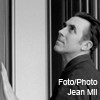| |
LUC PEIRE (Bruges 1916 – Paris 1994) evolved from Expressionism through a personal reduction and stylization of the human figure to presenting human beings as spiritual beings, symbolised in vertical movement and situated in a balanced space.

Portrait of Mrs. S. Vande Calseyde, 1937, CR 58. (Photo: JLP Foundation Archive)
|
1930-1940: apprenticeship - influence of Permeke
As a young art student in Bruges (1930-1935), Ghent (1932-1935) and Antwerp (1935-1940, under Gustave Van de Woestijne) Luc Peire learns sublimely the academic techniques of painting (Portrait of Mrs. S. Vande Calseyde, 1937, CR 58), but is also captivated by Constant Permekes' 'non-academic' approach.
With their uninhibited composition, colour and brushwork, the landscapes, portraits and interiors of this period betray the powerful and expressive visual language of the master of Jabbeke.
But in Peire there is no 'exaggerated' distortion of the subject of depiction.
Click on the image to enlarge |

Les Gosses (Kids), 1942, CR 141. (Photo JLP Foundation Archive)
|
1940-1946: war years - 'intimacy'
Peire's Expressionist period, influenced by Permeke, is followed by an animist interval, better described as 'intimate', attested to, inter alia, by the canvas Les Gosses (Kids) (CR 141) from 1942.
Click on the image to enlarge
|
| |
1947: influence of Italian fresco painting (Trecento and Quattrocento)
After resigning from La Jeune Peinture Belge (15 March 1947, along with Rik Slabbinck and Jack Godderis), Luc Peire is offered in the same year the opportunity to make a study trip to Italy and Sicily. He admires in particular the work of Giotto and Piero della Francesca.
From 1948 the structural principle of Italian fresco painting dominates his work. The figurative theme is elaborated on the two dimensional plane in a balanced composition with outlined shapes and colour areas. |

De blinden (Blind Persons), 1950, CR 390. (Photo JLP Foundation Archive)
|
1949-1951: Spain - Morocco - Balearic Inslands
The start of the schematization and reduction to the essence of the subject of depiction to give a harmonically structured and sophisticated play of bright colours emerges fully in 1949-1951 in Spain and in various locations in Morocco (De blinden (Blind Persons), 1950, CR 390).
In 1950 Luc Peire teaches himself al fresco painting in the Balearic Islands.
Click on the image to enlarge |

The Godderis Family, 1951, CR 455. (Photo JLP Foundation Archive)
|
1951: key work 'The Godderis Family'
As if influenced by the monumental character of fresco painting, Luc Peire goes on to paint on larger canvases (The Godderis Family, 1951, CR 455). Luc Peire achieves a powerful schematization and reduction to the essence of the depicted subject. Elimination of detail, simplification and stylization increase the structural power of the canvas. In The Godderis Family the artist achieves a perfect synthesis of different genres (still life, portrait, interior).
Click on the image to enlarge |
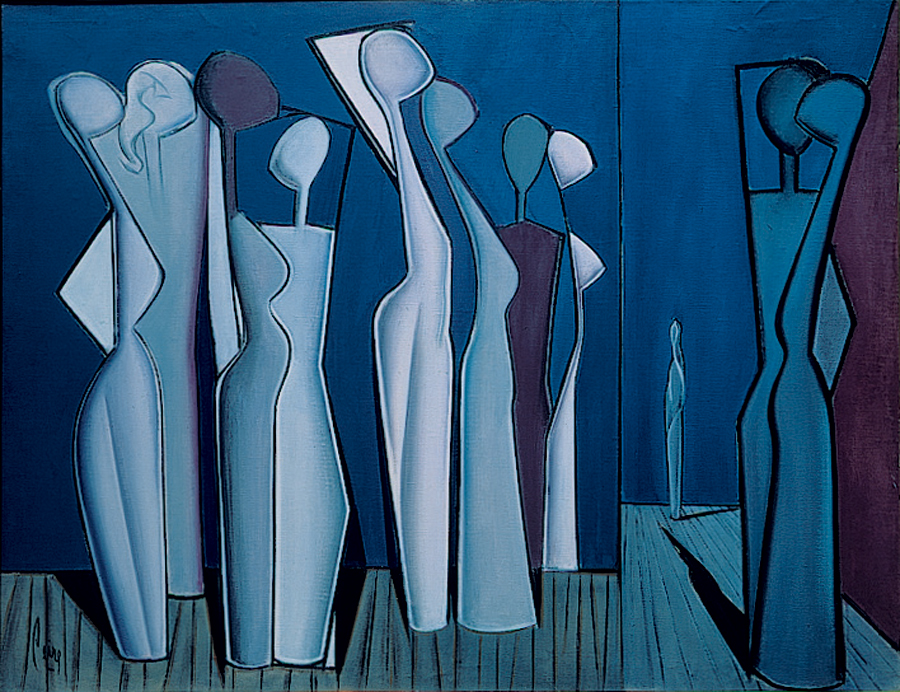
Denghese family, 1953, CR 551. (JLP Foundation Photo Archive)
|
1952-1953: Belgian Congo / Tenerife
A trip to the Belgian Congo and Tenerife (1952-1953) and the dialogue with Eduardo Westerdahl and Alberto Sartoris in Tenerife produce a new "artistic birth" in Luc Peire. From now works are created in which where man is no longer presented as an individual in a sensory, anecdotal fashion, but spiritually, universally, as "être humain", situated in a mostly empty space and in the metaphysical colours of blue, brown, black and white.
In the staging of Peire's paintings from 1953, the standing figures, simplified to outlined (metaphysical) silhouettes, are placed in (studio) interiors with different interior spaces, partitions, open doors, wood floor, palette, easel. 'Man' and 'space' will from now on dominate his work (Denghese Family, 1953, CR 551).
Click on the image to enlarge
|
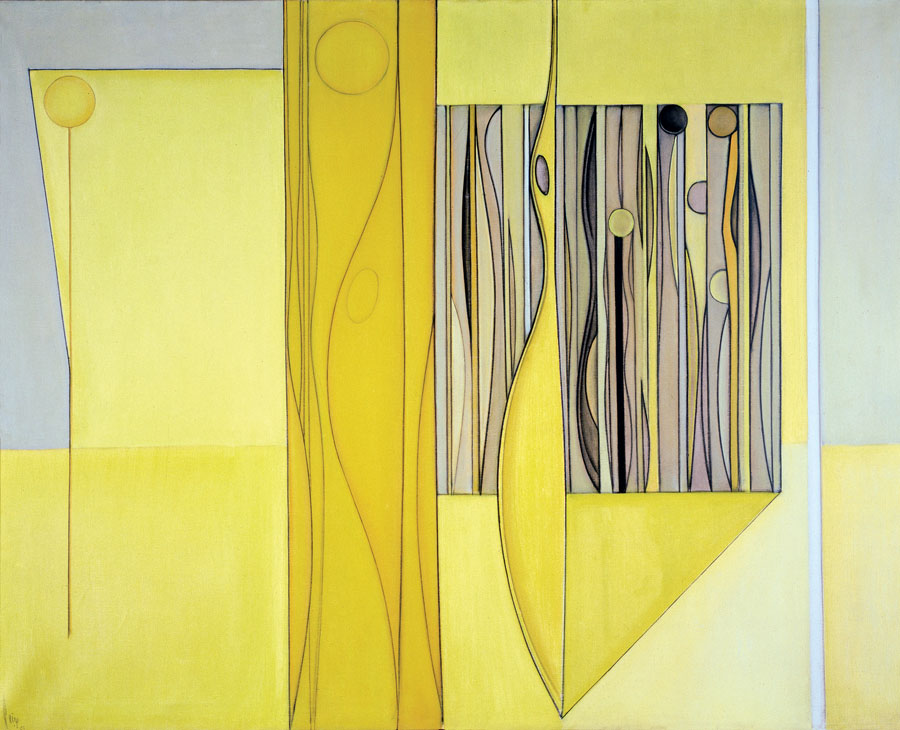
Mwinda Mingi, 1955, CR 626. (JLP Foundation Photo Archive)

Pigalle, 1960, CR 758. (JLP Foundation Photo Archive)

Olympos, 1962, CR 823. (JLP Foundation Photo Archive)
|
Mid-50s: further vertical abstraction - Paris
From 1954, the trend towards abstraction continues. Luc Peire enters into artistic dialogue with Spanish sculptor Josep María Subirachs and now searches out the Parisian art world where he comes into contact with Michel Seuphor and Leo Breuer.
From now on Luc Peire plays with variations of space (deep, open, compartmentalized, as decor). Human figures are thinned further in their verticality, or grouped into bundles of arabesques, influenced by the dynamics of tribal dancing encountered during his Belgian Congo tour. Afterwards, these move to a vertically (bundled) play of lines with suggestive curves and bends and the head as a circle shape (Mwinda Mingi, 1955, CR 626).
In a subsequent phase he divides the plane into vertical strips and bands. The painting becomes the scene of a game with varying surfaces, transparent architectural walls (Olympos, 1962, CR 823), bands of gradated colours (curtain effect) or pure lines, at times widened and deepened by a diagonal or a curve, or animated by smaller stand-alone geometric shapes (square, circle, triangle) (Pigalle, 1960, CR 758).
Click on an image to enlarge |
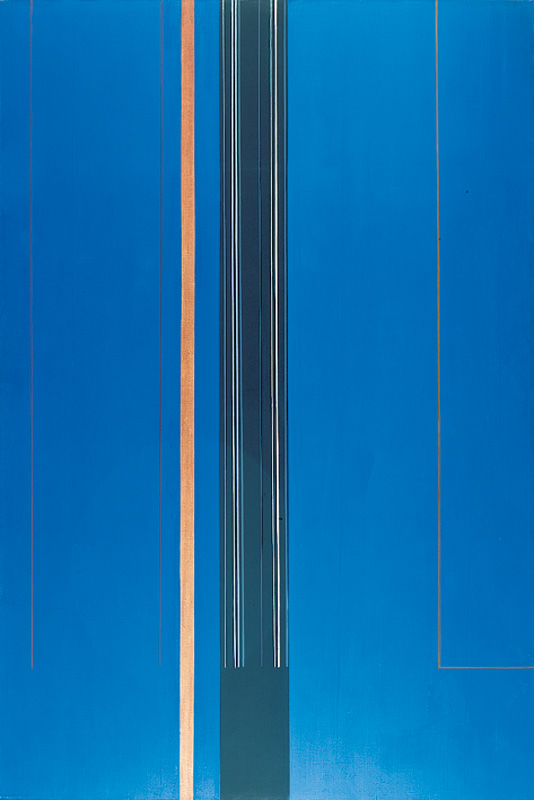
Venici, 1968, CR 1012. (JLP Foundation Photo Archive)
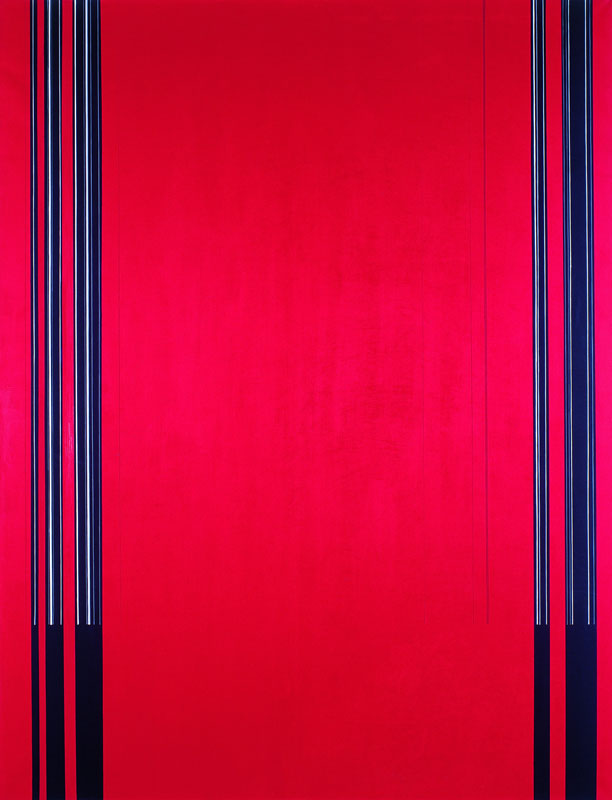
Tasman, 1988, CR 1368. (JLP Foundation Photo Archive)

Gymnopédie, 1981, CR 1306. (JLP Foundation Photo Archive)
|
From the mid '60s: abstract verticalism
From his stay in New York (1965/1966) until his last work (1992) Luc Peire, as an abstract verticalist, keeps to his thin verticals, narrow or wide stripes and bands of colour, initially grouped, with serene rhythms, at the centre of the canvas (Venici, 1968, CR 1012), (Tristan, 1968, CR 1018), (Bruges, 1968, CR 1019). Later these are found on the edges of a generally monochrome field (Tasman, 1988, CR 1368), (Pagilu, 1991, CR 1390), (Triangle, 1992, CR 1398).
Through his intense contact with the stylized simplicity, pure sobriety and the dominant power of space and light of the Romanesque abbey and church interior, Luc Peire paints monochrome greys as spiritual canvases (Sénanque, 1979, CR 1234), (Tournus, 1979, CR 1236), (Saintes, 1982, CR 1343).
His 'musically' constructed canvases include Gymnopédie (1981, CR 1306).
Click on an image to enlarge |

Graphie 1137, 1973, ILP 1137. (JLP Foundation Photo Archive)

Graphie 1291, 1992, ILP 1291 (JLP Foundation Photo Archive)

Environnement I , 1967, ILP 777. (Photo Jean Mil)
|
Drawing and Graphie
Already in earlier years, Luc Peire had rigorously implemented his verticalism in his finely nuanced pencil drawings and in the 'graphie': a personal art form in which painted-in black masses (on unalit, novapan, formica, panel, perspex, plexiglass, ...) are worked with engraver's tools. These are works in which Peire attains, through the virtuoso rhythmic contrast of white and black, a form of optical art into which he simultaneously brings in the musical parameter of 'time'.
(Graphie 1137, 1973 & Graphie 1291, 1992)
The graphie not only forms the essential constituent of the Groupe Lumino-Tours (1970) but also – to an 'infinitely' strong degree –his Environnement I (1967), Ambiente Mexico 68 (1968) and Environment III (1973). As a final consequence Luc Peire reaches here through mirror effects the climax of his artistic endeavour: vertical lines, space, infinity.
Click on an image to enlarge
|

Maine, 1972, engraving 39 (JLP Foundation Photo Archive)
 Integration work Muur Relief 68 (Wall relief 68) for J. van Breda & C° (Bank van Breda), Plantijn Moretuslei, Borgerhout-Antwerp, 1968. Photo Jean Mil Integration work Muur Relief 68 (Wall relief 68) for J. van Breda & C° (Bank van Breda), Plantijn Moretuslei, Borgerhout-Antwerp, 1968. Photo Jean Mil

Teken U.Z. Gasthuisberg, Leuven, 1992 (Landmark for Leuven University Hospital). (JLP Foundation Photo Archive)
|
Multidisciplinary
From 1967 onwards Luc Peire's multidisciplinary activities increase as a painter, engraver, illustrator and designer of architectural integrations in Belgium and France. (e.g. Muur Relief 68 for Bank van Breda, Borgerhout-Antwerpen, 1968 & Teken U.Z. Gasthuisberg, Leuven, 1992).
With his multiples (engraving, screen printing), architectural integrations and creations for interior decorations, public areas and the urban environment, Luc Peire strives to put across his artistic vision to a wide audience.
Click on an image to enlarge |
| |
Text: Marc Peire
Curator – Archivist, Luc Peire Studio – Jenny and Luc Peire Foundation, Knokke |
|
